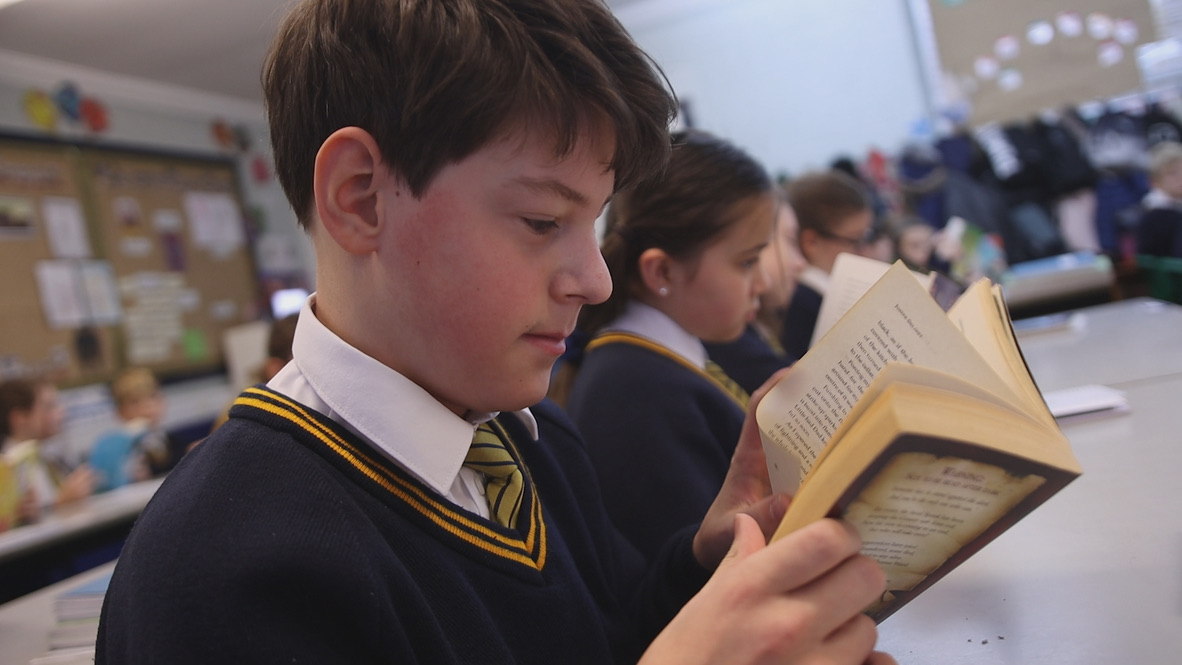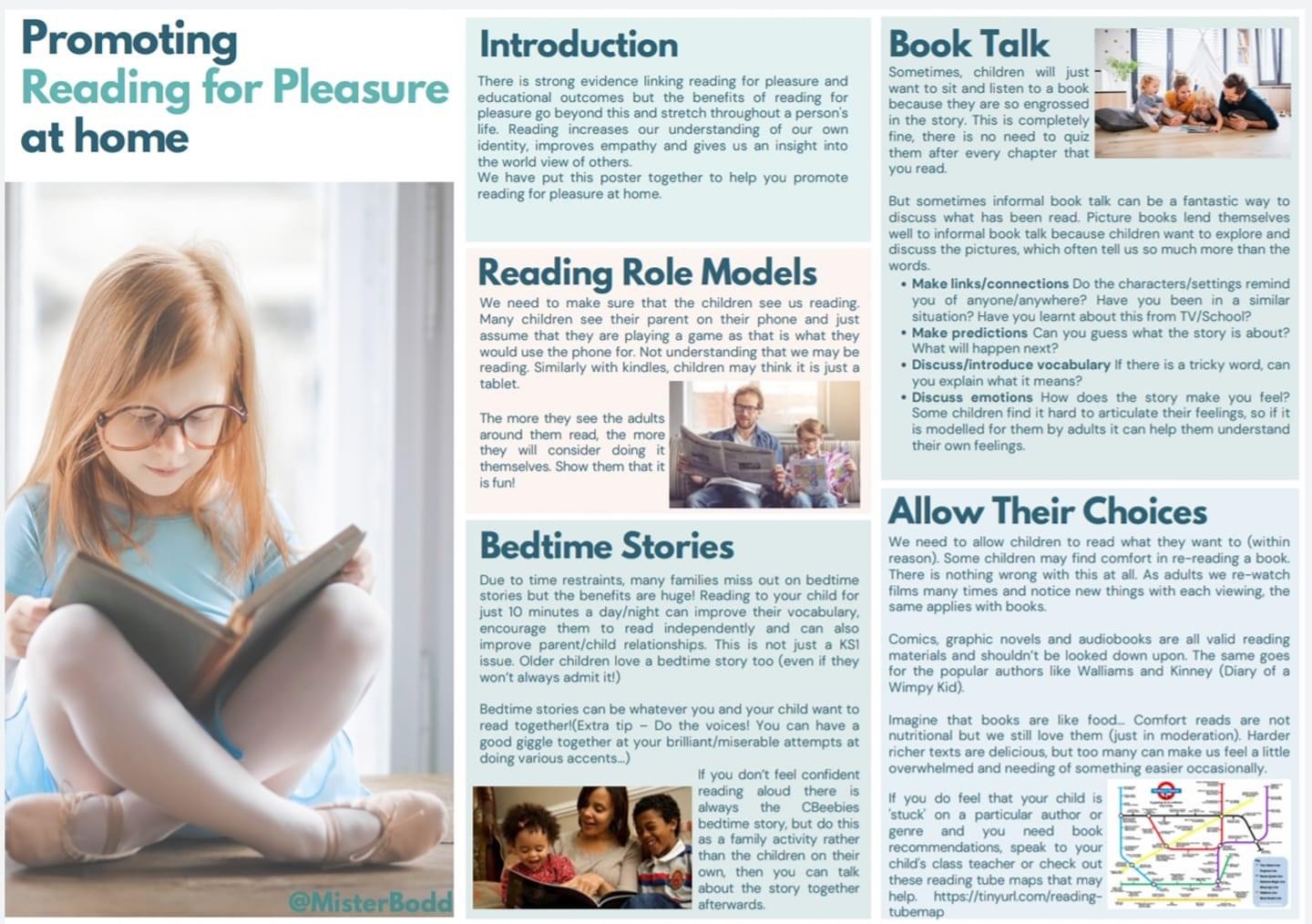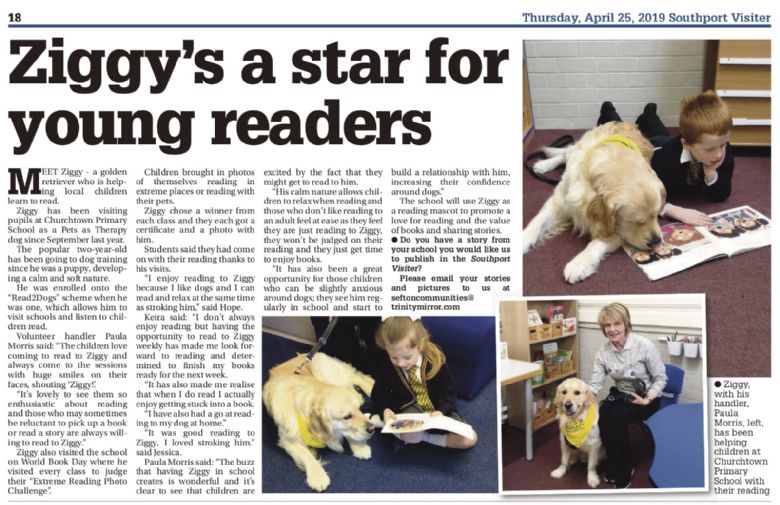
Reading and oracy is at the heart of our curriculum. At Churchtown we want our children to become enthusiastic, engaged readers and to develop a life-long love of books. We know that reading is important for both educational purposes as well as personal development, as it builds empathy, improves imagination and language development.
The teaching of reading is based on children having lots of opportunities to read widely, read fluently, understand what they are reading and have a love of books. In EYFS and KS1, children will be immersed in stories through ' 5 a-day' reading to empower children to be able to “read” and retell stories from a young age alongside phonics teaching. In KS2, children will share a Class Novel daily and engage with a ‘Buffet of Reading’ based around a theme each week. Through these, children will be exposed to a breadth of texts- fiction, non-fiction, poetry and song- and concepts discussed have been designed and balanced to reflect the diverse nature of society and develop their cultural capital.

Reading at Home

There is a positive relationship between reading frequency, reading enjoyment and attainment. Children who read for pleasure have increased concentration, memory, confidence, greater self-esteem and general knowledge.
Your child should be encouraged to read at home for 10 minutes or more each day. Your support is hugely important for developing their reading skills, confidence and understanding. Even if your child is an independent reader, it is still important for you to read with them, listen to them and discuss the books they are reading.
As children learn the skills needed to read, they will bring home levelled books (according to their stage of development). Once children have developed their ability to decode, children will bring home an age appropriate self-selected book from their class reading corner or corridor book shelves. Please encourage your child to change their book regularly so they can read each evening; speak to the class teacher if this is not happening.
How to support your child when reading at home:
- Try to listen to and read with your child regularly, 10 minutes a day is better than a longer session once a week. It can help if a regular time is set aside so that it becomes part of a routine.
- Read books to your child as well; if they see you enjoying a book it will encourage and motivate them to want to learn to read.
- Find a quiet place to share books where you can feel comfortable and relaxed – learning to read needs to be a positive experience - build their confidence by praising their efforts.
- During the early stages of reading, encourage your child to have a go at reading words, by using phonic skills to read any unfamiliar words, and by working on building up their sight vocabulary.
- Talk about the meanings of words to help to develop your child’s understanding and use of language.
- Encourage your child to read a range of texts such as stories, newspapers, comics, labels, poetry, non-fiction, tickets, signs, leaflets etc.
- Ask them questions about the text to develop their understanding.
Questions to Develop Understanding:
Where/when does the story take place?
Who are the characters in the story?
What happens in this part of the story?
Tell me one/two things that the main character does in this part of the story?
Can you retell the story using your own words?
Tell me what this character was like?
Tell me the most interesting/ exciting/ funniest/ your favourite part of the story? Why?
What do you think the character feels about...? How can you tell?
What do you think would have happened if…?
What do you think is going to happen next?
Which part of this book did you like best/least? Why?
How has the author used words/phrases to make this character funny/ sad/ clever/ frightening/ excited etc?
Why is … a good title for this story/book/chapter/play?
Do you know any more stories like this? Tell me how they are alike.
Do you know another story with similar characters in? Tell me how they are similar.
What do you think this story is trying to tell us?
Has anything like this ever happened to you?
Non Fiction
Tell me two things you found out that you didn’t know before.
What does this part of the text tell us about ….?
Which part of the text tells us about …?
Why are some words in bold?
How does this text/ layout help the reader?
How does (a diagram/picture/caption) help you to understand the information on this page?
If you have any questions or would like any further support please speak to your child’s class teacher.
Phonics
The Government strongly recommend the use of synthetic phonics when teaching early literacy skills, specifically Reading to children. Synthetic phonics is simply the ability to convert a letter or letter group into sounds that are then blended together into a word.
Reading opens the door to learning. A child who reads a lot will become a good reader. A good reader will be able to read more challenging material. A child who can read more challenging material is a child who will learn. The more a child learns, the more he or she will want to find out.
What is phonics?
Phonics is a way of teaching children to read quickly and skilfully. They are taught how to:
- Recognise the sounds that individual letters make
- Identify the sounds that different combinations of letters make-such as 'sh' or 'oo'
- Blend these sounds together from left to right to make a word
Children can then use this knowledge to 'decode' new words that they hear or see. This is the first important step in learning to read.
The children are taught to read words by blending, which means pushing all the sounds together to make a word. The children are taught to spell words by segmenting, which means sounding out words and writing down the sounds they can hear.
Why phonics?
Research shows that when phonics is taught in a structured way-starting with the easiest sounds and progressing to the most complex-it is the most effective way of teaching young children to read. It is particularly helpful for children aged 5 to 7 years old. Almost all children who receive good teaching of phonics will learn the skills that they need to tackle new words. Children can go on to read any kind of text fluently and confidently, and read for enjoyment. (Department for Education)
Read, Write, Inc
At Churchtown Primary School, we use the Read Write Inc (RWI) programme to get children off to a flying start with their early literacy skills. It is a phonics programme which helps all children learn to read fluently and at speed so they can focus on developing their skills in comprehension, vocabulary and spelling. The programme is designed for children aged 4-7. However, at Churchtown we begin the programme in Nursery and will continue teaching RWI to children beyond the age of 7 if they still need support in their reading.
RWI was developed by Ruth Miskin and more information on this can be found at https://ruthmiskin.com/en/find-out-more/parents/.
Mrs Standeven is our Phonics lead teacher, so if you have questions about phonics, contact school who can refer you to her. Please take the time to read the information as it will provide invaluable information as to how you can help and support your child in reading.
How will RWI be taught?
All children are assessed regularly by class teachers so that they work with children at the same level. This allows complete participation in lessons.
Nursery
When appropriate, children will be introduced to the initial sounds in short sessions.
Reception
In Reception all children will learn how to ‘read’ the sounds in words and how those sounds can be written down.
Reading
The children:
- learn 44 sounds and the corresponding letters/letter groups using simple picture prompts – see below
- learn to read words using Fred talk and sound blending
- read from a range of storybooks and non-fictions books matched to their phonic knowledge
- work well with partners
- develop comprehension skills in stories by answering 'Find It' and 'Prove It' discussion questions
Writing
The children:
- learn to write and form the letters/letter groups which represent the 44 sounds with the help of fun phrases
- learn to write words by using Fred Talk
- learn to build sentences by practising sentences out loud before they write
Talking
The children:
- They work in pairs so that they:
- answer every question
- practise every activity with their partner
- take turns in talking and reading to each other
- develop ambitious vocabulary
Year One & Two
Children follow the same format as Reception but will work on complex sounds and read books appropriate to their reading level. Daily sessions of RWI phonics last for 30 mins.
Children will be taught how to read as follows:
Before you start to teach your child, practise saying the sounds below. These are the sounds we use to speak in English.
Fred Talk
We use pure sounds (‘m’ not’ muh’,’s’ not ‘suh’, etc.) so that your child will be able to blend the sounds into words more easily.
At school we use a puppet called Fred who is an expert on sounding out words! we call it, ‘Fred Talk’. E.g. m-o-p, c-a-t, m-a-n, sh-o-p, b-l-a-ck.
The following video is an example of blending sounds with Fred. https://www.youtube.com/watch?v=dEzfpod5w_Q
Step 1:
Set 1 Sounds are taught in the following order together with rhymes to help children form the letters correctly and instantly recognise sounds ready for blending.
|
Set 1 |
|
|
Sound |
Rhyme |
|
m |
Down Maisie then over the two mountains. Maisie, mountain, mountain. |
|
a |
Round the apple, down the leaf. |
|
s |
Slide around the snake |
|
d |
Round the dinosaur's back, up his neck and down to his feet. |
|
t |
Down the tower, across the tower, |
|
i |
Down the insects body, dot for the head. |
|
n |
Down Nobby and over the net. |
|
p |
Down the plait, up and over the pirates face. |
|
g |
Round the girls face, down her hair and give her a curl |
|
o |
All around the orange |
|
c |
Curl around the caterpillar |
|
k |
Down the kangaroos body, tail and leg |
|
u |
Down and under the umbrella, up to the top and down to the puddle |
|
b |
Down the laces, over the toe and touch the heel |
|
f |
Down the stem and draw the leaves |
|
e |
Slice into the egg, go over the top, then under the egg |
|
l |
Down the long leg |
|
h |
Down the horse's head to the hooves and over his back |
|
sh |
Slither down the snake, then down the horse's head to the hooves and over his back |
|
r |
Down the robot's back, then up and curl |
|
j |
Down his body, curl and dot |
|
v |
Down a wing, up a wing |
|
y |
Down a horn, up a horn and under the yak's head. |
|
w |
Down, up, down, up the worm. |
|
th |
Down the tower, across the tower, then down the horse’s head to the hooves and over his back |
|
z |
Zig-zag-zig, down the zip. |
|
ch |
Curl around the caterpillar, , then down the horse's head to the hooves and over his back |
|
qu |
Round the queen’s head, up to her crown, down her hair and curl |
|
x |
Cross down the arm and leg and cross the other way |
|
ng |
A thing on a string |
|
nk |
I think I stink |
Please do not use letter names at this early stage.
Articulation of Phonemes:
http://www.youtube.com/watch?v=BqhXUW_v-1s
Children will also use pictures for each sound to help recognise the sound and then form the shape of the sound.
Step 2:
The children are then taught Set 2 Sounds - the long vowels. When they are very confident with all of set 1 and 2 they are taught Set 3 Sounds.
|
Long vowel sound |
Set 2 Speed Sound cards Teach these first |
Set 3 Speed Sound cards |
|
|
ay |
ay: may I play |
a-e: make a cake |
ai: snail in the rain |
|
ee |
ee: what can you see |
ea: cup of tea |
e: he me we she be |
|
igh |
igh: fly high |
i-e: nice smile |
|
|
ow |
ow: blow the snow |
o-e: phone home |
ao: goat in a boat |
|
oo |
oo: poo at the zoo |
u-e: huge brute |
ew: chew the stew |
|
oo |
oo: look at a book |
|
|
|
ar |
ar: start the car |
|
|
|
or |
or: shut the door |
aw: yawn at dawn |
|
|
air |
air: that’s not fair |
are: share and care |
|
|
ir |
ir: whirl and twirl |
ur: nurse for a purse |
er: a better letter |
|
ou |
ou: shout it out |
ow: brown cow |
|
|
oy |
oy: toy for a boy |
oi: spoil the boy |
|
|
ire |
|
ire: fire fire! |
|
|
ear |
|
ear: hear with your ear |
|
|
ure |
|
ure: sure it’s pure? |
|
Nonsense words (Alien words)
As well as learning to read and blend real words children will have plenty of opportunities to apply their sound recognition skills on reading ‘Nonsense words’. These words will also feature heavily in the Year One Phonics Screening check in the summer term. The Year 1 phonics screening check is a short, light-touch assessment to confirm whether individual pupils have learnt phonic decoding to an appropriate standard.
It will identify the children who need extra help so they are given support by their school to improve their reading skills. They will then be able to retake the check so that schools can track pupils until they are able to decode.
Step 3:
Children will be introduced to ‘Ditty books’ when they successfully begin to read single words. The short vowels should be kept short and sharp:
Children use sound-blending (Fred Talk) to read short ditties. Children will then be challenged to use their developing phonic knowledge to write short sentences.
Within all the books children will have red and green words to learn to help them to become speedy readers. Red words are words that are not easily decodable and challenge words to extend children’s vocabulary. Green words are linked to the sounds they have been learning and are easily decodable. During the RWI session children will read their book and at each new reading they will have plenty of opportunities to practise using their developing comprehension skills.
Phonics Screening Check Year One
What is the Year 1 phonics screening check?
The Year 1 phonics screening check is a short, light-touch assessment to confirm whether individual pupils have learnt phonic decoding to an appropriate standard. They have to read 40 real and nonsense words. We call the nonsense words ‘Alien words’ and the children practice reading them every day.
It will identify the children who need extra help so that they are given support by their school to improve their reading skills. They will then be able to retake the check so that schools can track pupils until they are able to decode.
If you want to see an example of a previous years test click here.
What do the Phonics terms mean?
Phoneme: The smallest unit of sound in a word, e.g. c/a/t, sh/o/p, t/ea/ch/er.
Grapheme: A letter or group of letter representing one sound, e.g. sh, igh, t.
Clip Phonemes: when teaching sounds ,always clip them short ‘mmmm’ not ‘muh’
Digraph: Two letters which together make one sound, e.g. sh, ch, ee, ph, oa.
Split digraph: Two letters, which work as a pair, split, to represent one sound, e.g. a-e as in cake, or i-e as in kite.
Trigraph: three letters which together make one sound but cannot be separated into smaller phonemes, e.g. igh as in light, ear as in heard, tch as in watch.
Segmentation: means hearing the individual phonemes within a word – for instance the word ‘crash’ consists of four phonemes: ‘c – r – a – sh’. In order to spell this word, a child must segment it into its component phonemes and choose a grapheme to represent each phoneme.
Blending: means merging the individual phonemes together to pronounce a word. In order to read an unfamiliar word, a child must recognise (‘sound out’) each grapheme, not each letter (e.g. ‘th-i-n’ not ‘t-h-i-n’), and then mergethe phonemes together to make the word.
Mnemonics: a device for memorising and recalling something, such as a hand action of a drill to remember the phoneme /d/.
Adjacent consonants: two or three letters with discrete sounds, which are blended together e.g. str, cr, tr, gr. (previously consonant clusters).
Comprehension: understanding of language whether it is spoken or written.
Ziggy our Reading Dog
